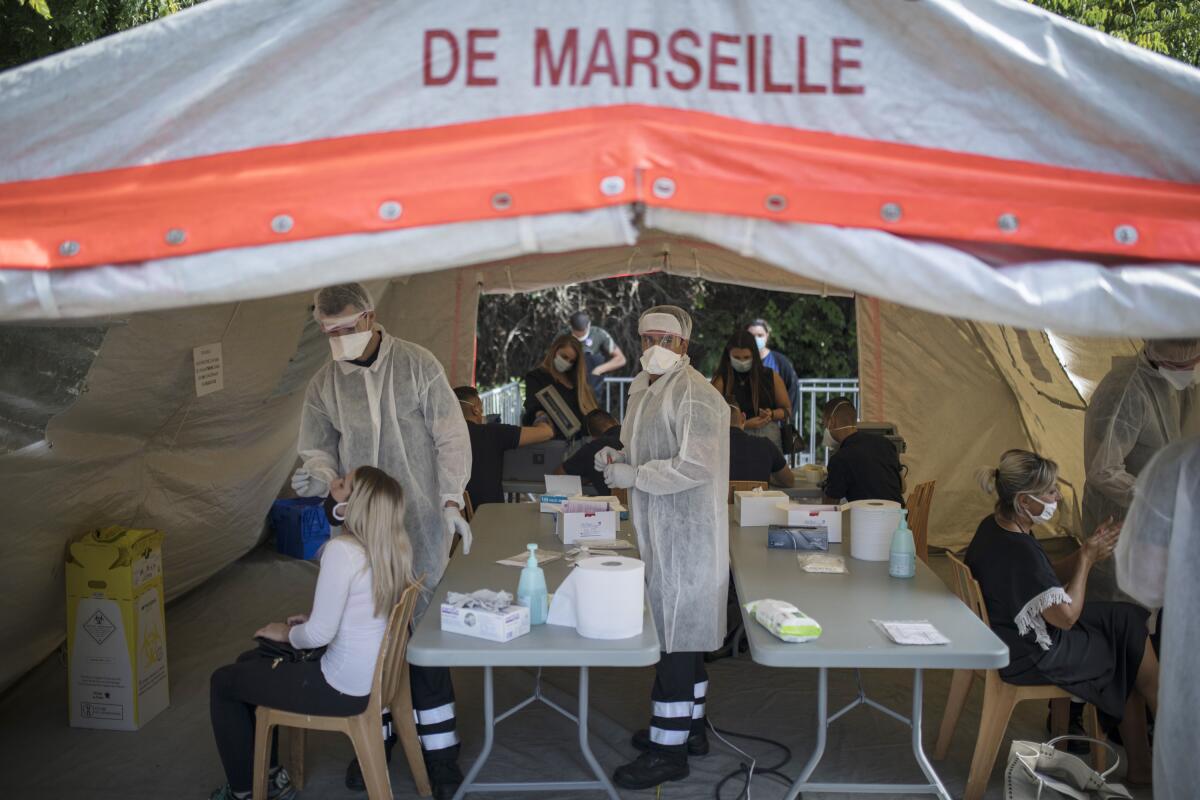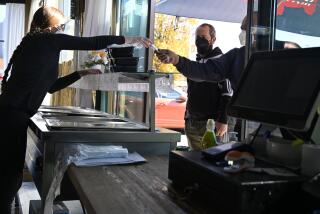As coronavirus again soars in Europe, officials look to targeted restrictions

- Share via
MARSEILLE, France — From medieval times onward, this Mediterranean port has known the lash of pestilence.
Three centuries ago, Marseille was the locus of Europe’s last epidemic of bubonic plague, which killed 100,000 people in and near the city, despite disease-fighting measures that included an intricate maritime quarantine system and a “plague wall” snaking across the surrounding countryside.
Now the novel coronavirus is stalking Marseille. After hospitalizations in France’s second-largest city nearly tripled over the course of a month, reaching almost 180, the national government in late September imposed tougher-than-elsewhere restrictions in Marseille, closing its restaurants and bars while allowing those in other parts of the country to remain open.
The Marseille measures were among a growing number of localized disease-fighting restrictions across Europe, where coronavirus infections are on the rise again, but where there’s little political appetite for national lockdowns like those in the spring.
The result has been a patchwork of new rules that can vary not only from country to country but also from one municipality or even neighborhood to the next. Local officials in Madrid are fighting restrictions against travel in and out of the Spanish capital and its suburbs. Pubs in Glasgow and Edinburgh, Scotland’s biggest cities, can’t serve alcohol indoors. Starting this weekend, Berlin’s all-night club scene will have to shut down at the party’s-just-starting hour of 11 p.m.
With more than 1 million deaths worldwide, economies battered and daily life in nearly every corner of the globe upended by the pandemic, epidemiologists and economists alike say smaller-scale targeted interventions — aimed at particular cities, or certain types of establishments — can work well at quelling smaller outbreaks before they become big ones. But they can also spur discord, division and an aggrieved sense of being singled out.
The World Health Organization’s Europe director, Dr. Hans Henri Kluge, spoke Tuesday of “pandemic fatigue” — not only the near-universal exhaustion over the relentless march of the virus but also a severe fraying of the social solidarity that underpins successful public health measures.
Even in some countries credited with important early success in fighting COVID-19 with shutdowns, mask-wearing and social distancing, things have taken a turn for the worse. In Germany, new cases have touched highs not seen since April as fears grow of another lockdown, which would imperil Europe’s biggest economy.
Germany’s caseload had fallen sharply through the summer, dropping from nearly 7,000 new infections a day to the low hundreds, thanks in part to a widespread shutdown of businesses and schools in the spring. Germans on the whole dutifully followed social-distancing regulations, combined with efficient contact tracing by its Gesundheitsaemter, or regional health offices. Now, though, new cases are back to numbering more than 4,000 a day.
Marseille, an ancient maritime hub turned multicultural metropolis, last month had the unhappy distinction of becoming the first mainland French city to land in the government’s “dark red” category, subject to the strictest measures. Paris has since been moved into that category, and six other cities are likely to make the list as well.
Among the nearly 1 million Marseillaises — the city’s inhabitants, from whom France takes the title of its national anthem — the restrictions fueled worry and frustration. Local leaders warned that police might not enforce them. The city’s new mayor got in a Twitter spat with the country’s health minister.
“We were really shocked that the dialogue wasn’t there,” said Laurent Llardhit, Marseille’s assistant mayor for tourism and the economy.
The tightening of local measures elsewhere also triggered rebellions by hard-hit businesses. In the southern city of Toulouse, gym owners persuaded a judge to block the orders and let them remain open. Business owners in the northern industrial city of Lille marched through the streets. Parisians angered by a restaurant-closing order — later eased — sarcastically posted photos of commuters cramming onto the Metro.
Not so long ago, the French were willing to accept far harsher measures. During the two-month nationwide lockdown that began March 17, people were ordered to remain at home, with only limited excursions for work and food.
When those strictures loosened, a bit of joie de vivre returned. People went back to taking vacations, sitting in movie theaters and sipping cocktails on restaurant terraces expanded for social distancing. Schools, for the most part, opened on time in early September and have remained in session.
In recent weeks, though, the virus reasserted itself. France’s two-week tally of new cases — nearly 170,000 — far outstripped the total reported during the two-month lockdown. Stepped-up testing accounts for some of the jump, but transmission rates and hospitalizations have climbed significantly.
The government of President Emmanuel Macron has made some concessions to those angered by restrictions. Officials announced that establishments forced to close could apply for up to about $12,000 in financial aid and that laid-off employees’ wages would be covered for the rest of the year. After meeting with big-city mayors, the health minister also agreed that restaurants in cities such as Paris and Marseille could remain open with restrictions, though bars remained shuttered.
Collisions between the cold reality of the virus and a dreamed-of return to normality are a pan-European phenomenon.
In Berlin, case numbers recently took an especially worrying leap. Four districts in the German capital with a combined population of 1 million in a city of 3.5 million residents were classified as “high-risk zones” after reporting more than 50 new cases per 100,000 residents for seven straight days.
Two northern German states, Schleswig-Holstein and Lower Saxony, then introduced quarantines and test requirements for would-be holidaymakers from those particular Berlin districts.
“I am worried that Berlin is on the verge of losing control of the situation,” Bavaria’s state governor, Markus Soeder, said Wednesday. “We don’t want to have a situation like in Madrid and Paris where there had to be a complete lockdown, where public life was set back to zero.”
Chancellor Angela Merkel last week met with the governors of Germany’s 16 states and agreed to tighten region-specific restrictions in hopes of preventing another nationwide lockdown. She also delivered a stern warning that a second shutdown might be unavoidable.
“I am appealing to everyone: Obey the rules that we’ll have to keep in place for a while,” Merkel said in a speech to Parliament. “Let’s all take better care of each other.”
In a relatable expression of pandemic angst, Merkel, a trained scientist, said she fully understood her compatriots’ desire to return to life as it was before the coronavirus.
“I feel that strongly myself — I’m no different than anyone else,” she said. “We’ve got to be patient and smart to save lives. This will depend on each and every one of us.”
These are anxious days for businesspeople like Walter Rauhe, who opened a cafe with a friend just before the nationwide lockdown in March. They managed to survive and even thrive — in part thanks to a generous landlord who waived a month’s rent, and in part by pivoting from coffee hangout to a wine bar where people quaff drinks outdoors.
“It would be a total disaster for us if they shut us down again for two months,” said Rauhe, 56. The German government, he said appreciatively, is “clearly trying to nip it in the bud with isolated regional measures.”
Located in a designated high-risk zone, Rauhe’s cafe will soon have to close its doors two hours earlier than previously, at 11 p.m. But having an older clientele helps ease the sting; at other establishments, younger revelers are just getting revved up at that hour.
Rauhe wasn’t sure if it was pandemic anxiety that had made wine more alluring than coffee, but he feared another wide-ranging shutdown might push both him and his customers to the brink.
“If we survive another lockdown,” he said with a laugh, “we might have to turn it into a whiskey bar.”
Times staff writer King reported from Washington. Special correspondents O’Brien and Kirschbaum reported from Marseille and Berlin, respectively.
More to Read
Sign up for Essential California
The most important California stories and recommendations in your inbox every morning.
You may occasionally receive promotional content from the Los Angeles Times.











